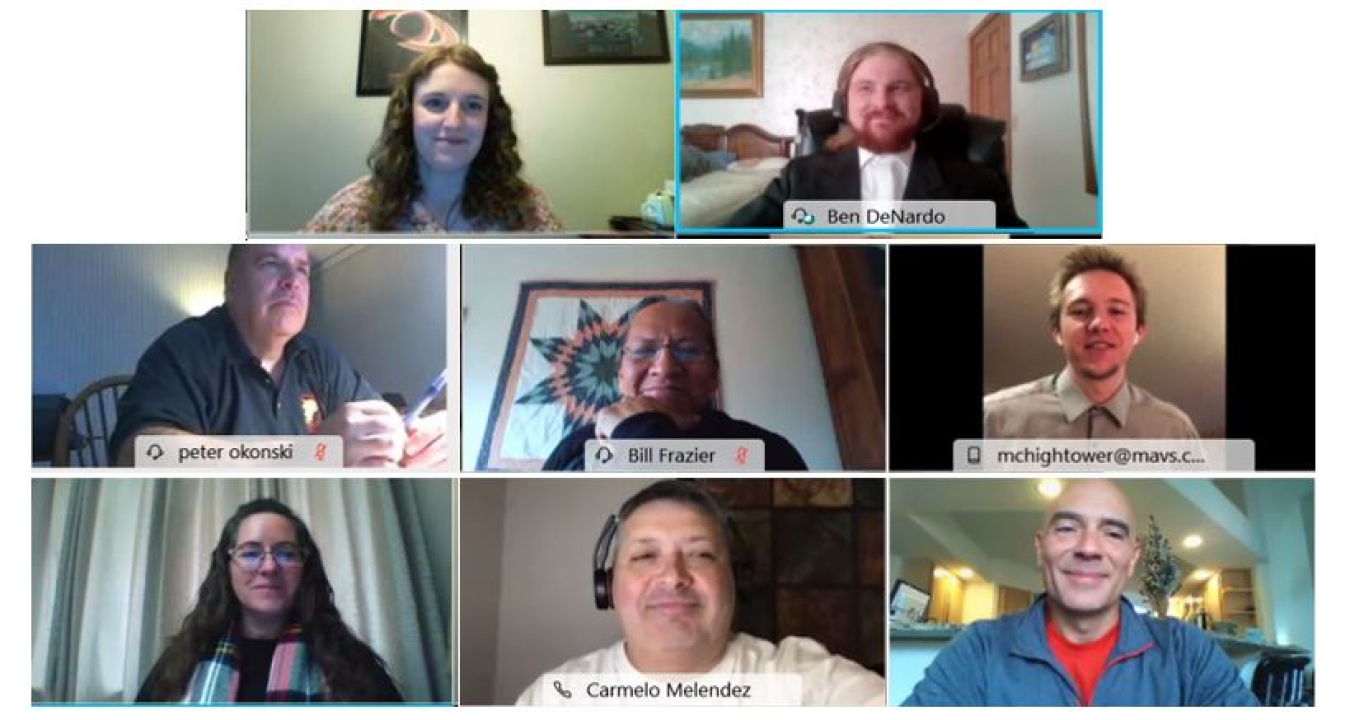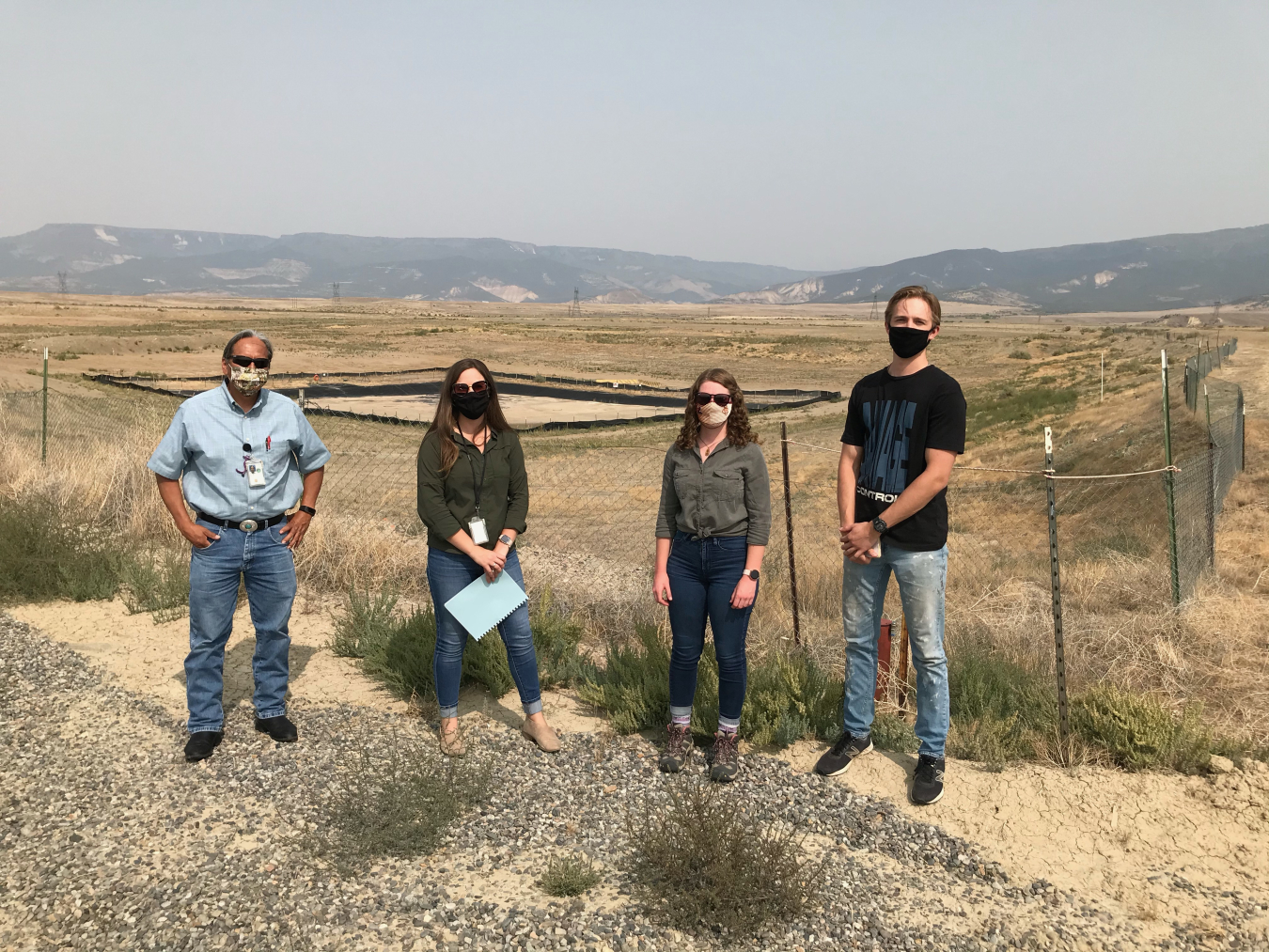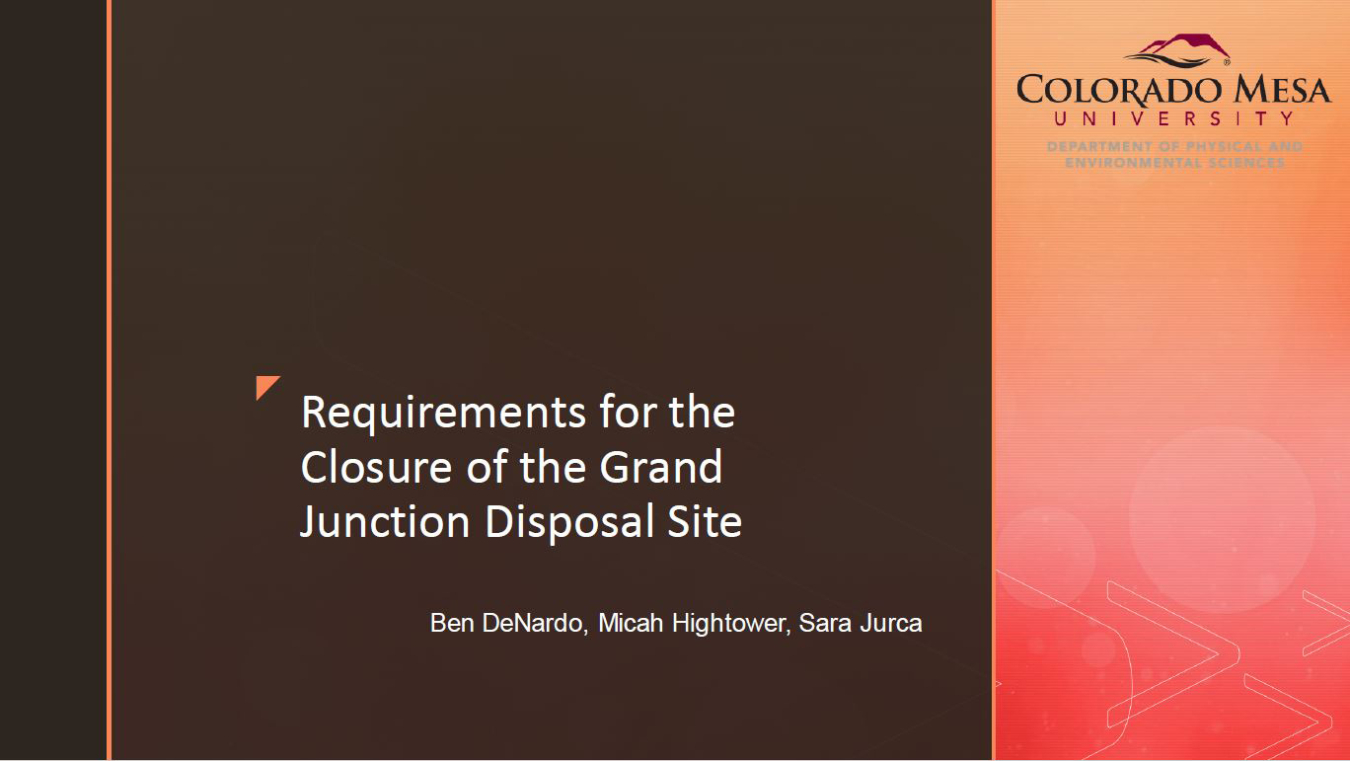CMU students present capstone project on regulatory requirements for eventual closure of the Grand Junction disposal site.
February 10, 2021
LM Director Carmelo Melendez, LM Deputy Director Peter O’Konski, LM Site Manager Bill Frazier, and UMTRCA Supervisor for LM Paul Kerl listen in as students from Colorado Mesa University present their capstone project.
Three environmental science undergraduate students at Colorado Mesa University (CMU) in Grand Junction, Colorado, presented their senior capstone project to an audience of U.S. Department of Energy (DOE) Office of Legacy Management (LM) officials in December 2020, including LM Director Carmelo Melendez and Deputy Director Peter O’Konski.
Bill Frazier, site manager of LM’s Grand Junction, Colorado, Disposal Site (GJDS), introduced the students — Ben DeNardo, Micah Hightower, and Sara Jurca. The three conducted research throughout their fall semester on the regulatory guidance governing the closure of the GJDS and LM requirements for site closure.
LM has managed the GJDS since 2003, conducting routine site inspection and maintenance, records-related activities, and stakeholder support. The GJDS currently holds 4.5 million cubic yards of contaminated material and has room to hold an additional 230,000 cubic yards under the Uranium Mill Tailings Radiation Control Act (UMTRCA). GJDS was previously approved to remain open until capacity is reached or until 2023, whichever comes first. As a part of the 2020 OMNIBUS spending bill, an extension was approved and the GJDS is now scheduled for closure in 2031.
“While legislation approved on Dec. 27, 2020, extended the disposal cell closure until 2031, the findings of the research project will remain a relevant and valuable resource as LM continues closure plans focused on the new date,” said Frazier.
LM’s existing relationship with CMU opened the door for the capstone project, when CMU approached Kirk Roemer, LM Strategic Partner (LMSP), with the idea of a project focused on the GJDS. With an eye toward 2023, LM tasked the CMU capstone students with a complex set of questions: “What is required for closure of the GJDS? Does LM need a closure plan according to U.S. Nuclear Regulatory Commission (NRC) guidance, or are the current LM documents, including the Interim Long-Term Surveillance Plan, Site Completion Report, and Final Design Plan, sufficient?”
Freddy Witarsa, an assistant professor of environmental science and technology at CMU and the advising professor on the capstone project, was excited to see his students begin to utilize all they’ve learned in his classes.
“The project allowed the students to apply skills that they were taught during their undergraduate careers and allowed them to do so in a way that is impactful,” said Witarsa.

LM Site Manager Bill Frazier, LM Physical Scientist Sara Woods, and CMU students Sara Jurca and Micah Hightower on site at the Grand Junction disposal site.
An easing of COVID-19 restrictions in early fall allowed the small group of students to tour the site in-person, while the rest of their research was conducted online. They met with Frazier, Roemer, and LMSP Environmental Engineer Paul Wetherstein biweekly, as they researched the regulatory guidance and gained valuable insight from the GJDS team. The students ultimately concluded that a closure plan is not required by NRC. However, they also determined that the plan may be a useful document for internal use and could assist with planning procedures and timelines necessary to meet NRC requirements in the future.
CMU student Ben DeNardo expressed gratitude for the opportunity to engage in practical work with LM.
“It has been a pleasure working with everyone, and we learned a ton about how laws are put into practice and how legal guidance is interpreted,” said DeNardo.
This gratitude is reciprocated by Frazier, who emphasized the value added to LM by the work of the CMU students.
“The capstone senior student project was a great opportunity for both DOE and students to engage in solving a real-world problem,” Frazier said. “As we all know, solutions to real-world problems are difficult and sometimes uncertain. But these extraordinary students were eager to learn and willing to do the work. Their research and recommendations helped identify the problem for government decisionmakers and stakeholders. They did a wonderful job and I truly believe in their success in the future.”

Over the course of the fall 2020 semester, CMU students researched closure guidelines and procedures to provide LM with a recommendation for the GJDS.
The successful completion of the capstone project and well-attended presentation is just the latest in many successful collaborations between the LM office in Grand Junction and CMU students.
Earlier in 2020, CMU environmental science students planned to visit the GJDS as part of their course curriculum. Due to the COVID-19 pandemic and subsequent shutdown, an in-person visit to the site was not possible. As an alternative, LM provided a web conference with Frazier and Roemer.
CMU students not only took advantage of the opportunity to learn from LM engineers and scientists, they have also contributed to the site’s interpretive services initiatives.
In the fall of 2019, staff from the Atomic Legacy Cabin (ALC) at the Grand Junction office and a group of students in Steven Schulte’s public history course at CMU collaborated to create a temporary exhibit for display in the interpretive center. The display, “Atomic Pop Culture,” showcases the role of nuclear science and its influence on American culture from the 1950s to the present through interpretive panels and multiple artifacts (e.g., games, comic books, and dinnerware). The exhibit is currently on display at the Tomlinson Library at CMU.
An internship with LMSP brought 2019 CMU graduate Ashton Peterhans’ talents to the ALC, where she engaged in exhibit content and design, public affairs, and large-event planning. Peterhans was a valuable team player who contributed greatly to the completion of the exhibits in the ALC and its ribbon-cutting ceremony. She has since been rehired as an interpretive specialist for LMSP.
These collaborative CMU and LM success stories are a part of the LM goal of engaging stakeholders in the communities where the office’s sites are located.

